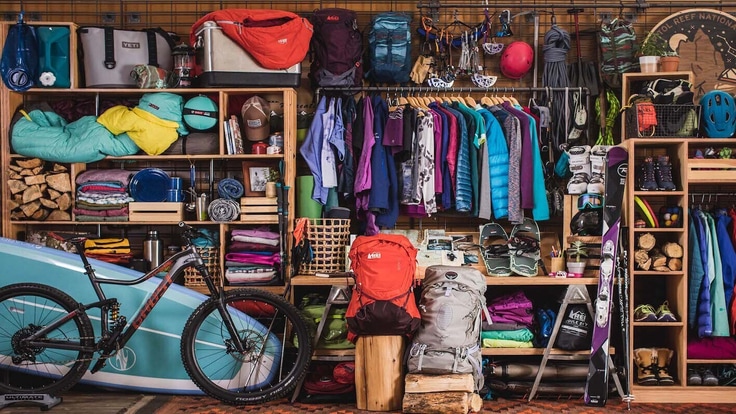The outdoor industry has long obsessed over each and every gear innovation. Lighter, stronger, more capable gear has helped make outside adventures more achievable and ambitious trips more conceivable. But the latest thing often comes with a steep price tag, which is fine if you can afford it, but a potential budget buster for many. Our obsession with the latest and greatest also contributes to overfull gear closets and items ending up prematurely in landfills.
We have an alternative, though: shopping for used gear and clothing. The idea isn't new, but it has experienced a renaissance in recent years. Brands are embracing the used gear and clothing business as a way to welcome a broader (less affluent) base of people outside and to expand product offerings in a less resource-intensive way.
Purchasing used gear and clothing offers key advantages over buying new gear:
- Can provide substantial savings: Saving on big-ticket items like tents or bags can help you get quality equipment within a limited gear budget.
- Reduces environmental impact: On average, a used item represents a carbon savings of 50% or more over buying new, even accounting for shipping and handling costs.
- Expands your selection beyond the current year: Used gear might even be your only option if new gear supply shortages arise or you seek a cherished-but-discontinued item.
- Lets you benefit from gear evolution over the years: Used gear today is light years ahead of yesteryear's army surplus gear.
Where to Find Used Outdoor Gear
The used gear marketplace is evolving, as are your shopping options. Those options generally fall within the following categories:
Used Gear from Outdoor Brands and Retailers
Patagonia's Worn Wear is well known, but others have emerged, like Arc'Teryx used gear. REI's first foray into not-new gear sales happened in 1962, when a burst pipe inundated its only store in Seattle and the co-op undertook a major cleaning and remerchandising effort in order to hold a "flood sale." That event gave rise to a varying range of used gear options for members over the years, including store garage sales and used gear sections (both featuring returned items rather than flood-salvaged ones). In 2018 the co-op opened its online used gear store, which has grown rapidly in recent years.
Highlights:
- Brand or store handles financial transaction and vets merchandise.
- When needed, items get minor repairs and cleaning before being resold.
- Multibrand new-gear sellers will also have multiple brands in used-gear inventories.
Used-Gear Stores and Thrift Shops
Used-gear stores tend to be local businesses, though there are also national chains. Your odds of having a great local used-gear store are better in places where outdoor recreation is popular. General goods thrift stores might also have some outdoor gear and clothing on their shelves.
Highlights:
- Shop handles financial transaction and vets items (occasionally refurbishing them).
- Local shops' gear selections often reflect primary activities in a region (e.g. shops in ski towns are likely to have a lot of used skis.)
Peer-to-Peer Sites
You negotiate directly with the person who owns the used gear, typically through an intermediary, like an online marketplace that may charge a fee for its services. This option includes both well-known general merchandising marketplaces and a growing number of sites that specialize in outdoor gear. Shopping at a neighborhood garage sale or buying from acquaintances are in-real-life peer-to-peer options.
Highlights:
- Great deals can be found, but shopping is less convenient than with a full-service online site.
- Requires due diligence because neither the individual seller nor their gear go through a thorough vetting process.
Used Outdoor Gear and Clothing Shopping Tips
Do your research: Read online customer reviews of a new or similar version of the item; scrutinize notes on attached tags or in online descriptions to see about issues specific to that particular item. Also check seller reviews.
Check return policies: These range from none at all to extremely generous; generally, though, return policies on used items are more limited than for new ones. A lot of in-person sales are "as is," meaning the onus is on you when you examine the gear because you can't return it later.
Check back often: Supply chains are in effect crowdsourced, so used-gear inventories can vary widely and change quickly; also check multiple online sites and stores, especially for hard-to-find items.
Don't hesitate if you find a promising item: Used-gear inventories are eclectic, not deep, so individual items may not be available for long.
Don't get too specific: If you're open to a range of brands and models, you'll have more choices.
Test-drive gear you can see in person: Set up a tent, ride a bike or hike around in boots.
Used footwear can be a great value: Bargains can be had because many people avoid items that have had other people's feet in them, even if they were returned solely because a customer changed their mind prior to hitting the trail. (Bring a clean pair of socks if you're shopping in person.)
Embrace cosmetic flaws: Stains or minor scratches can mean a lower price for you without impairing the performance of an item.
Keep an eye out for rental sales: Places that offer gear rentals upgrade their inventory on a rolling basis. Their used items will have some wear, but should also be well maintained.
Never buy safety gear: Reputable used-gear sellers steer clear of items like climbing ropes or bike helmets. If you see that type of protective gear for sale, that's a red flag about the seller.
Clean and maintain gear you buy: A little gear wash can spruce dingy items right up and immediately renewing DWR (durable water repellent) on rainwear, outerwear and waterproof footwear will help them perform at their best. Check out our care and repair articles for tips on extending the life of any item you own, new or used.



